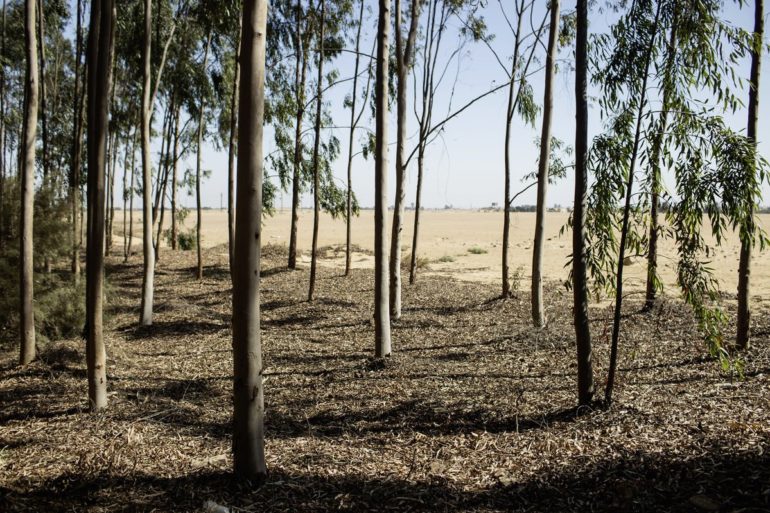Rainfall isn’t something that comes in abundance in Egypt. While the Mediterranean coastline gets more than the rest of the country, the capital city of Cario only receives around 29 millimeters of rain a year and some of Egypt’s desert areas to the south may only see rain once every few years.
Despite this harsh desert climate where life struggles to survive, rising out of the desert is an oasis known as the Serapium Forest. The forest is surrounded by the Sahara sands and encompasses some 500 acres where eucalyptus, teak, and mahogany trees flourish. So how is it that this lush forest not only survives but thrives and continues to slowly grow against the harsh desert climate? Sewage water.
This desert forest is relatively new and has only been in existence since the 1990s, but it’s the result of an ambitious wastewater treatment experiment that seems to be working. Launched by the Egyptian government to comply with recommendations set by the 1992 UN Rio conference on climate change, the forest sits atop the drainage basin for the sewage water of nearby Ismailia, a city of around 400,000. Whereas the soil here would normally have zero chance at growing such a forest, the trees are able to withstand the sun’s 2,200 kilowatt-hours per square meter intensity, thus rejuvenating the soil with their shade.

Managing this growing forest requires more than simply planning out where the water from Ismailia ends up. Ahmed Ragaie, along with a crew of 18 workers manages one section of the forest where they maintain a network of irrigation tubes that feed water from the adjacent drainage basin to the forest root system. Each tree receives five liters of water a day and the water and because the human wastewater is so rich in nitrogen even after treatment, extra fertilizers aren’t needed.
The team takes careful measures to ensure that the sewage effluent is properly treated and tested to prevent environmental contamination of the soil. It starts by filtering out the garbage and household waste such as plastic and paper. Next, oxygen and microbes are added to decompose the actual waste with the end result being top-notch water for fertilization of plant life.
While this two-stage process wouldn’t clean the water enough for growing crops for human consumption, for trees in the middle of a desert forest, however, it’s perfectly fine.
Fighting Back Desertification
The ambitious effort is being carried out with the goal of fighting back the creeping spread of the desert. Otherwise known as desertification. While this is a natural occurrence, the death of once fertile or semi-arable areas becoming desert brings with it problems of sustainability for both plant and animal life.
It’s nothing new either and is believed to have played a part in the decline of the Sumerian and Babylonian empires. If crops can’t be grown, a civilization is ultimately on a downward spiral. According to the UN Environment Programme, desertification today is only getting worse and around 60 percent of the African continent is either desert or on its way to becoming desert.
Hany El Kateb, a forestry scientist at the Technical University of Munich, sees the success of the Serapium Forest as a method for fighting the desert’s spread. “We can use this to create badly needed jobs in arid regions worldwide, giving people a reason not to leave their home countries,” El Kateb said.

Maintaining a heavy tree cover would be vital to the forest’s health, but at the same time, the trees could be selectively harvested. For example, after around 15 years, the Egyptian eucalyptus trees would be ready for harvesting and could produce 350 cubic meters of wood per 100 acres. It would take a pine plantation around 60 years to produce the same amount.
Are More Forests on the Way?
With the prosperous success of the Serapium Forest, scientists are hopeful that more of the country’s desert can be turned into forests. Research has suggested that there’s the potential for using the country’s sewage water to replenish a substantial section of Egypt’s desert into a commercially viable forest. “Egypt’s 97 million inhabitants produce seven billion cubic meters of wastewater every year, enough to green 1.6 million acres of desert,” El Kateb said. Currently, Egypt must import all of its raw wood products from other countries.
German companies have also taken an interest in the Serapium Forest model. ForestFinance, a sustainable company that has worked on economic development, CO2 absorption, and wildlife conservation in countries with rich forests, such as Vietnam and Panama, is teaming up with Egypt. The goal is to cultivate a plantation on the site and work towards increasing the number of tree species. “We see the use of wastewater and desert land as an opportunity to build an economic model for sustainable forestry in arid regions,” Managing Director of Forest Finance, Dirk Walterspacher, said. “This is where climate protection, the push back of the desert, wastewater recycling and sustainable forest management interlock.”

Because Egypt is 96 percent desert and the Nile is too valuable of a source for drinking water, using the country’s sewage water seems to be the most economical solution for the growth of the forests. Because of political instability, the future of the Serapium Forest is still very much uncertain. Even so, Hany El Kateb is hopeful for what lays ahead and believes that if done right, other forests in the arid desert sands can blossom.
Photos via Twitter @Botaniachka
